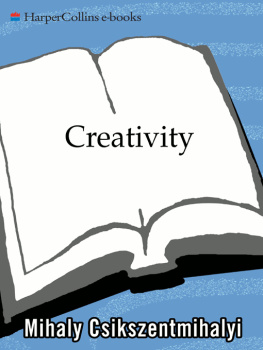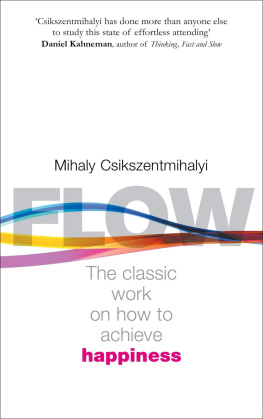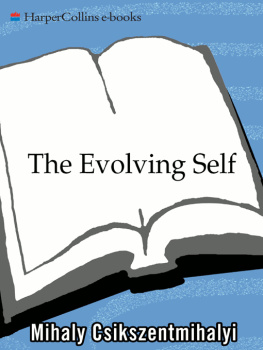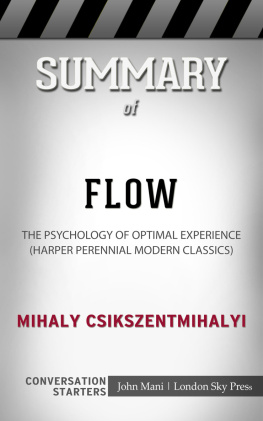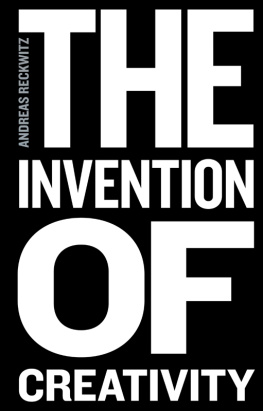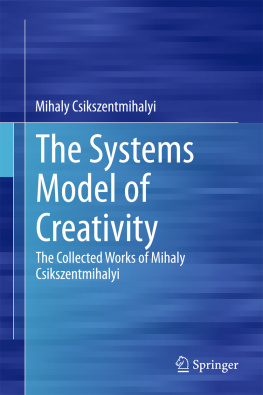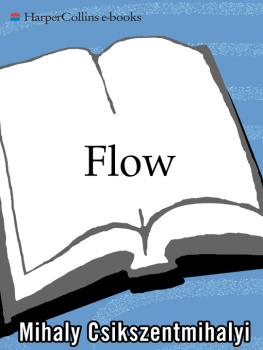Csikszentmihalyi - Creativity : flow and the psychology of discovery and invention
Here you can read online Csikszentmihalyi - Creativity : flow and the psychology of discovery and invention full text of the book (entire story) in english for free. Download pdf and epub, get meaning, cover and reviews about this ebook. City: New York, NY, Pymble, NSW, year: 2007, publisher: HarperCollins e-books, genre: Religion. Description of the work, (preface) as well as reviews are available. Best literature library LitArk.com created for fans of good reading and offers a wide selection of genres:
Romance novel
Science fiction
Adventure
Detective
Science
History
Home and family
Prose
Art
Politics
Computer
Non-fiction
Religion
Business
Children
Humor
Choose a favorite category and find really read worthwhile books. Enjoy immersion in the world of imagination, feel the emotions of the characters or learn something new for yourself, make an fascinating discovery.
- Book:Creativity : flow and the psychology of discovery and invention
- Author:
- Publisher:HarperCollins e-books
- Genre:
- Year:2007
- City:New York, NY, Pymble, NSW
- Rating:3 / 5
- Favourites:Add to favourites
- Your mark:
- 60
- 1
- 2
- 3
- 4
- 5
Creativity : flow and the psychology of discovery and invention: summary, description and annotation
We offer to read an annotation, description, summary or preface (depends on what the author of the book "Creativity : flow and the psychology of discovery and invention" wrote himself). If you haven't found the necessary information about the book — write in the comments, we will try to find it.
Creativity : flow and the psychology of discovery and invention — read online for free the complete book (whole text) full work
Below is the text of the book, divided by pages. System saving the place of the last page read, allows you to conveniently read the book "Creativity : flow and the psychology of discovery and invention" online for free, without having to search again every time where you left off. Put a bookmark, and you can go to the page where you finished reading at any time.
Font size:
Interval:
Bookmark:
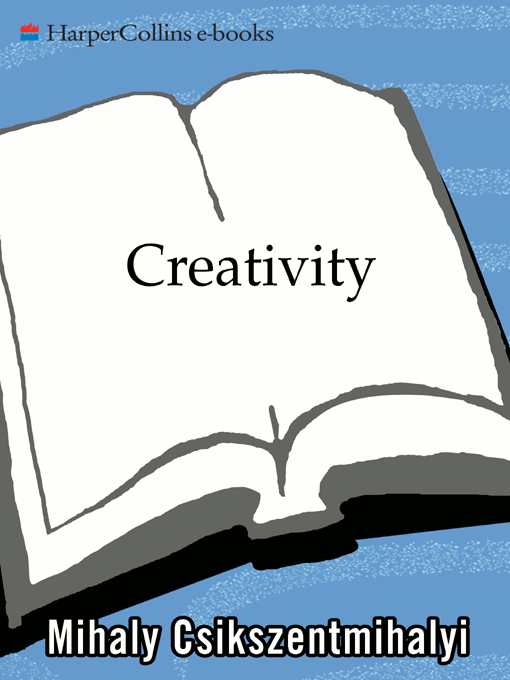
F LOW AND THE P SYCHOLOGY OF D ISCOVERY AND I NVENTION

P ART I
T HE C REATIVE P ROCESS
P ART II
T HE L IVES
P ART III
D OMAINS OF C REATIVITY
The idea for this book emerged in a conversation with Larry Cremin, then president of the Spencer Foundation. We agreed that it would be important to study creativity as a process that unfolds over a lifetime, and that no systematic studies of living creative individuals existed. With its customary vision, the Spencer Foundation then financed a research project, which was to last four years, to remedy this gap in our understanding. Without this grant the laborious task of collecting, transcribing, and analyzing the lengthy interviews would have been impossible.
The other contribution without which this book could not have been written is the assistance of the ninety-one respondents whose interviews form the bulk of the book. All of them are extremely busy individuals, whose time is literally invaluablethus I deeply appreciate their availability for the lengthy interviews. It is indeed difficult to express my gratitude for their help, and I can only hope that they will find the results were worth their time.
A number of graduate students helped with this project and often contributed creatively to it. Several have written or coauthored articles about the project in professional journals. Especially important were four of my students who have been involved in the project since its inception and who have since earned their doctorates: Kevin Rathunde, Keith Sawyer, Jeanne Nakamura, and Carol Mockros. The others who took an active part are listed among the interviewers in appendix A, which describes the sample.
While we collected and analyzed the data, I had many opportunities to consult with fellow scholars whose specialty is creativity. I should mention at the very least Howard Gardner, David Feldman, Howard Gruber, Istvan Magyari-Beck, Vera John-Steiner, Dean Simonton, Robert Sternberg, and Mark Runcoall of whom contributed, knowingly or not, to the development of ideas in this book.
Several colleagues helped with earlier drafts of the manuscript. I am particularly glad to acknowledge the inspiration and critique of my old friend Howard Gardner, of Harvard University. As usual, his comments have been exactly on target. William Damon, of Brown University, made several excellent suggestions that helped reorganize the contents of the volume. Ben Csap, from the University of Szeged, Hungary, brought a different cultural perspective to the work.
Three chapters of the book were drafted while I was a guest of the Rockefeller Foundation in its Italian Center at Bellagio. The rest were written while I was a fellow at the Center for Advanced Studies in the Behavioral Sciences in Palo Alto, with support from the John D. and Catherine T. MacArthur Foundation grant #8900078, and the National Science Foundation grant #SBR9022192. I am grateful to them for the opportunity to concentrate on the manuscript without the usual interruptionsand in such glorious surroundings.
In the later stages of the work, Isabella Selega, who had the good grace to consent to marry me some thirty years ago, oversaw the editing of the manuscript and many other important details. She did the same when I wrote my doctoral dissertation in 1965 on the same topic. It is difficult for me to admit how much of whatever I have accomplished in the years in between I owe to her loving, if critical, help.
None of the shortcomings of this book should be attributed to any of those mentioned here, except myself. For whatever is good in it, however, I thank them deeply.
T his book is about creativity, based on histories of contemporary people who know about it firsthand. It starts with a description of what creativity is, it reviews the way creative people work and live, and it ends with ideas about how to make your life more like that of the creative exemplars I studied. There are no simple solutions in these pages and a few unfamiliar ideas. The real story of creativity is more difficult and strange than many overly optimistic accounts have claimed. For one thing, as I will try to show, an idea or product that deserves the label creative arises from the synergy of many sources and not only from the mind of a single person. It is easier to enhance creativity by changing conditions in the environment than by trying to make people think more creatively. And a genuinely creative accomplishment is almost never the result of a sudden insight, a lightbulb flashing on in the dark, but comes after years of hard work.
Creativity is a central source of meaning in our lives for several reasons. Here I want to mention only the two main ones. First, most of the things that are interesting, important, and human are the results of creativity. We share 98 percent of our genetic makeup with chimpanzees. What makes us differentour language, values, artistic expression, scientific understanding, and technologyis the result of individual ingenuity that was recognized, rewarded, and transmitted through learning. Without creativity, it would be difficult indeed to distinguish humans from apes.
The second reason creativity is so fascinating is that when we are involved in it, we feel that we are living more fully than during the rest of life. The excitement of the artist at the easel or the scientist in the lab comes close to the ideal fulfillment we all hope to get from life, and so rarely do. Perhaps only sex, sports, music, and religious ecstasyeven when these experiences remain fleeting and leave no traceprovide as profound a sense of being part of an entity greater than ourselves. But creativity also leaves an outcome that adds to the richness and complexity of the future.
An excerpt from one of the interviews on which this book is based may give a concrete idea of the joy involved in the creative endeavor, as well as the risks and hardships involved. The speaker is Vera Rubin, an astronomer who has contributed greatly to our knowledge about the dynamics of galaxies. She describes her recent discovery that stars belonging to a galaxy do not all rotate in the same direction; the orbits can circle either clockwise or counterclockwise on the same galactic plane. As is the case with many discoveries, this one was not planned. It was the result of an accidental observation of two pictures of the spectral analysis of the same galaxy obtained a year apart. By comparing the faint spectral lines indicating the positions of stars in the two pictures, Rubin noted that some had moved in one direction during the interval of time, and others had moved in the opposite direction. Rubin was lucky to be among the first cohort of astronomers to have access to such clear spectral analyses of nearby galaxiesa few years earlier, the details would not have been visible. But she could use this luck only because she had been, for years, deeply involved with the small details of the movements of stars. The finding was possible because the astronomer was interested in galaxies for their own sake, not because she wanted to prove a theory or make a name for herself. Here is her story:
It takes a lot of courage to be a research scientist. It really does. I mean, you invest an enormous amount of yourself, your life, your time, and nothing may come of it. You could spend five years working on a problem and it could be wrong before you are done. Or someone might make a discovery just as you are finishing that could make it all wrong. Thats a very real possibility. I guess I have been lucky. Initially I went into this [career] feeling very much that my role as an astronomer, as an observer, was just to gather very good data. I just looked upon my role as that of gathering valuable data for the astronomical community, and in most cases it turned out to be more than that. I wouldnt be disappointed if it were only that. But discoveries are always nice. I just discovered something this spring thats enchanting, and I remember how fun it was.
Font size:
Interval:
Bookmark:
Similar books «Creativity : flow and the psychology of discovery and invention»
Look at similar books to Creativity : flow and the psychology of discovery and invention. We have selected literature similar in name and meaning in the hope of providing readers with more options to find new, interesting, not yet read works.
Discussion, reviews of the book Creativity : flow and the psychology of discovery and invention and just readers' own opinions. Leave your comments, write what you think about the work, its meaning or the main characters. Specify what exactly you liked and what you didn't like, and why you think so.

